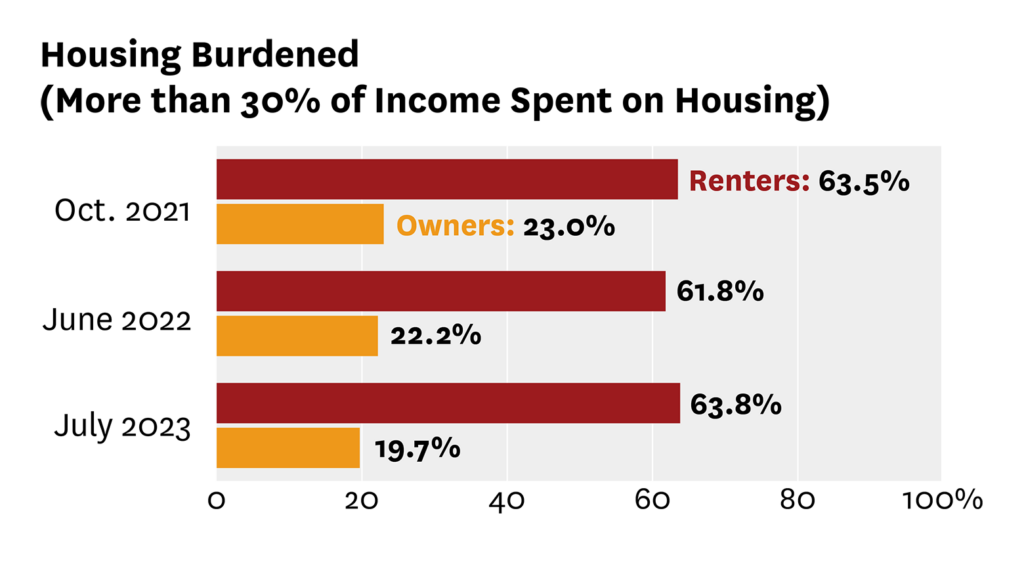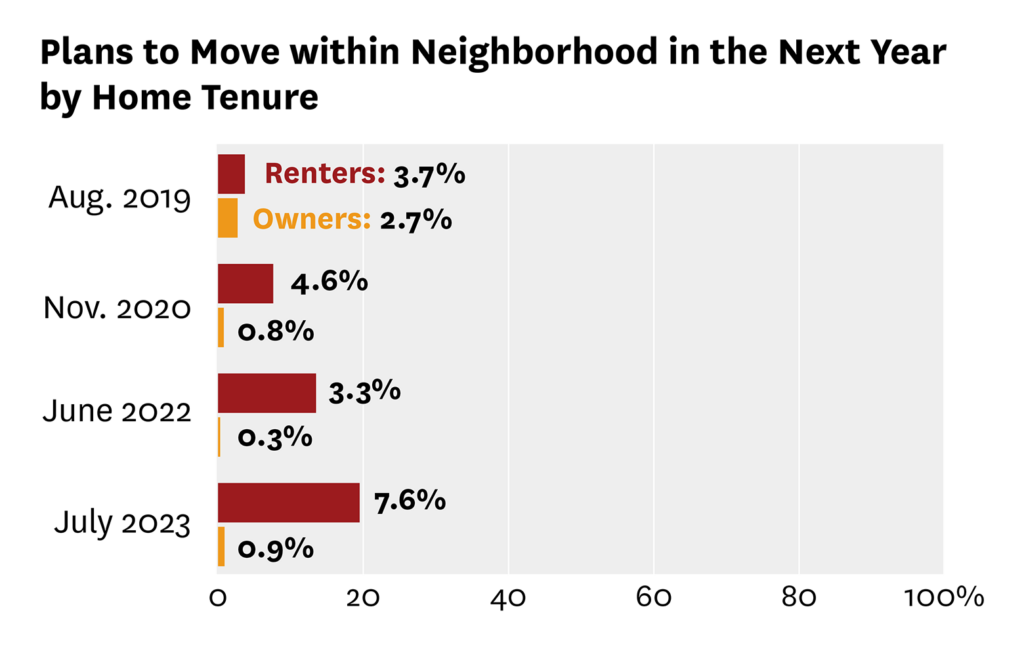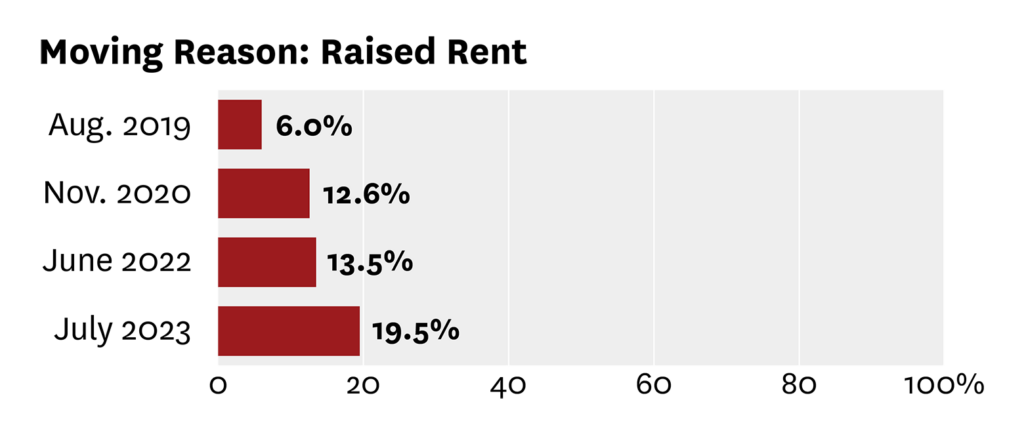At the height of the COVID-19 pandemic, many predicted the rise of remote work, coupled with the pandemic’s outsized impact on health and financial well-being in cities, would drive people out of urban areas like Los Angeles and into cheaper, less densely populated areas. Confirming fears of an urban exodus, our LABarometer survey made local headlines when it revealed that 1 in 10 Angelenos planned to leave L.A. County in the next year, a 25% increase from 2019.
Census data later corroborated what our survey had predicted. From July 2020 to July 2022, Los Angeles County experienced exceptionally high rates of out-migration and exceptionally low rates of in-migration, resulting in a net population loss of 294,211.
In the last two years, however, rates of out-migration have slowed. From 2022 to 2023, the county had a net population loss of just 56,420, according to Census data, and in our latest survey fewer than 3% of residents reported plans to leave L.A. this year – a 70% decrease from what we saw at the height of the pandemic and a 60% decrease from what residents were reporting even before the pandemic, in 2019.

Why did housing plans change? And what can they tell us about residents’ lives in the wake of the pandemic? To explore these questions, our research team analyzed four waves of LABarometer survey data collected from 2019 to 2024.
LABarometer surveys are distributed twice a year to a panel of 2,000 residents randomly selected from households throughout Los Angeles County. The two surveys – one on Livability & Affordability, the other on Mobility & Sustainability – cover a wide range of topics, from residents’ housing conditions and well-being, to their transportation use and views on climate change. We wanted to understand how and why residents’ housing plans had changed, so we analyzed data from the Livability & Affordability survey, which tracks key dimensions of housing, healthcare, food, and educational access in L.A.
Here are some things we learned:
Many low-income residents wanted to leave L.A. during the pandemic, but never did.
In November 2020, 10% of respondents indicated plans to leave L.A. in the next year – a 25% increase from the year prior. The top reasons residents cited for leaving were housing-related. Over 23% of residents who planned to leave L.A. said they were moving due to housing in LA being unaffordable and nearly 25% of residents who planned on leaving expressed their desire to purchase a home rather than rent. Those who planned to move due to housing costs tended to be lower income, while those who expressed their desire to purchase a home tended to be higher income.
By 2022, 32% of these intended out-movers were no longer in our sample – in all likelihood, because they were no longer living in L.A. That means about two-thirds of the residents who planned to leave L.A. at the height of the pandemic never did.
What distinguished those who left from those who didn’t? Household income.
Typically, L.A.’s out-movers have skewed lower income. Indeed, at the height of the pandemic, 13% of low-income residents (making less than $60,000) had indicated plans to leave L.A. compared to 3% of high-income residents (income of $100,000+). Yet, low-income residents were also some of the hardest hit by pandemic hardships like financial insecurity, food insecurity, and unemployment. This may explain why low-income residents were the least likely to follow through on their out-migration plans. Among intended out-movers, just 28% of those who were low-income had left our study by 2022, compared to 52% of those who were high-income.
Now faced with a national housing crisis that has made even mid-size cities and suburbs prohibitively expensive, low-income residents – once, the income group most likely to leave L.A. — are as likely as anyone else to stay put.
Plans to move anywhere – even within L.A. – have declined.

Just 5% of residents reported plans to move to a different neighborhood in L.A. this year. That is a 40% decrease from what we saw in 2020 and a 50% decrease from what we saw in 2019. This suggests the change over time we’re seen in housing plans is not unique to out-migration and is likely attributable to the worsening affordable housing crisis, which has made it more challenging for people to move out of their homes, let alone across counties. The change over time may also be tied to a larger, national decline in moving rates.
Among renters and homeowners, a growing material and experiential divide
When we look at the breakdown of housing plans by homeownership status, our results show clearly that renters fluctuate a lot more than homeowners in their housing plans. Year to year, renters, who comprise 52% of L.A. residents, are planning moves at higher rates than homeowners, who comprise 46% of L.A. residents, and their plans have largely mirrored the twists and turns of the pandemic: Increasing in 2020, as remote work grew and interest rates plummeted, and decreasing by 2022, as remote work declined and housing costs spiked. This stands in stark contrast to the pandemic experience of homeowners who have exhibited a steady decline over time in their willingness to move.

Differences like these highlight the material and experiential divide between renters and homeowners. Nearly 64% of renters in L.A. are housing-cost-burdened, meaning they spend over 30% of their household income on housing costs, which makes them more vulnerable to economic shocks like the pandemic. In contrast, just 20% of homeowners in our study are considered housing cost burdened. Furthermore, despite rising housing costs, cost burden declined 2.5 percentage points among homeowners between 2022 and 2023 – a sign that homeownership is increasingly only accessible to the exceedingly wealthy.

Signs of growing housing insecurity among renters
While few L.A. renters plan to move to a new neighborhood or city this year, the percentage of renters planning to move to new housing within their current neighborhood has doubled since 2022, reaching 7.6%.

For some, plans to move to new housing may be forced moves spurred by the expiration of certain COVID-related renter protections. Since 2021, we have seen a significant increase in the number of people moving because their landlord raised the rent. Nearly 20% of respondents who moved last year report that one of their primary reasons for moving was an increase in rent. That’s a 50% increase from last year, when 13% of recent moves were attributed to an increase in rent, and a nearly 300% increase from 2019, when just 6% of recent moves were due to an increase in rent.

What next?
While the social and economic upheaval of the pandemic pushed some residents out of L.A., it kept many more residents in place. Today, Angelenos appear more settled than ever. Yet change is on the horizon, as more renters are plotting their next move and increased housing costs, coupled with the rollback of COVID-19 eviction protections, have left a growing number of renters at risk of displacement.
To learn more about life in Los Angeles and how it has changed since 2019, check out our latest report or visit our website.
LABarometer is a research center housed at the USC Dornsife Center for Economic and Social Research (CESR). We conduct basic and applied social science research on issues affecting Los Angeles County residents, with the aim of informing academic research, public discourse, and policy. At the heart of our research is the LABarometer Panel, a probability-based Internet survey panel of approximately 2,000 adults randomly selected from households throughout Los Angeles County. The LABarometer Panel is a sub-panel of the Understanding America Study.
Sign up for Schaeffer Center news



You must be logged in to post a comment.